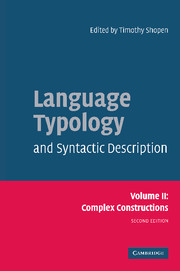Book contents
- Frontmatter
- Contents
- List of figures
- List of tables
- List of contributors
- Acknowledgements
- List of abbreviations and symbols
- 1 Coordination
- 2 Complementation
- 3 Noun phrase structure
- 4 Relative clauses
- 5 Adverbial clauses
- 6 Discourse structure
- 7 Sentences as combinations of clauses
- Bibliography
- Language index
- Subject index
7 - Sentences as combinations of clauses
Published online by Cambridge University Press: 26 December 2009
- Frontmatter
- Contents
- List of figures
- List of tables
- List of contributors
- Acknowledgements
- List of abbreviations and symbols
- 1 Coordination
- 2 Complementation
- 3 Noun phrase structure
- 4 Relative clauses
- 5 Adverbial clauses
- 6 Discourse structure
- 7 Sentences as combinations of clauses
- Bibliography
- Language index
- Subject index
Summary
Introduction
In discourse, whether dialogue or monologue, simple predications combine into larger units. Clauses – the surface structure units which correspond most closely to individual predications – combine into clusters of clauses which are distinguished in most languages as sentences versus paragraphs. Sentences are tighter bundles than paragraphs. They commonly have more cross-reference between their component parts (clauses) and more ‘closure’ (i.e., it is somewhat easier to tell where one stops and another starts) than is the case with combinations of sentences which we call paragraphs. Although paragraphs encode essentially the same relations (see section 2) as those found in sentence structures, they are looser and more diffuse. Paragraphs typically do not have as many overt grammatical ties between their component sentences as do the parts of the sentence itself. Nor do paragraphs usually have grammatical closure (see, however, Foré in section 4.1).
In this chapter I feature the sentence with only passing attention to the paragraph. The sentence is considered here not as a unit consisting of a predicate and nouns related to it (a simple clause), but rather as a combination of such units (clauses) into still larger structures of the sort here summarized. This chapter describes the notions encoded in these combinations of clauses and goes on to describe and illustrate the formal features of sentences thus defined in languages around the world.
- Type
- Chapter
- Information
- Language Typology and Syntactic Description , pp. 372 - 420Publisher: Cambridge University PressPrint publication year: 2007
- 39
- Cited by



